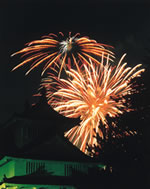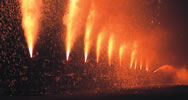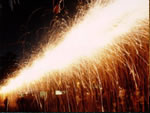|
|
 |
 |
 |
|
 |
 |
 |
|
|
 |
|

Writings on the fireworks
in Yoshida (the former name of Toyohashi)
have been found in the archives of Yoshida
Shrine. While the scale of the festival was
considered small, the archives state that
various types of fireworks were fired, making
it one of the longest running festivals in
Japan. So long in fact, that the famous Tezutsu
hand-held fireworks are thought to have originated
at Yoshida Shrine.
Gunpowder was considered a weapon and was
kept under strict control by the samurai during
the Sengoku period, however peasants in the
region were permitted to use and manufacture
gunpowder for use in bonfires at Shrines.
The use of gunpowder in the region has a long
history as peasants were permitted to continue
their tradition of using gunpowder during
the rule of Tokugawa and subsequent lords
loyal to him.
Fireworks in Yoshida only started to become
as impressive as the current Gion Festival
fireworks after the City was reformed during
1688 to 1704. Images of the fireworks display
were even printed in the Edo to Kyoto Highway
Picture Collection of 1797. The fireworks
continued to gather popularity around the
country, being praised by famous author Bakin
Takizawa. The fireworks festival was also
ranked alongside Hitachi Mito (present day
Mito City in Ibaragi Prefecture) and Kai Omon
(present day Ichikawa Omon Town in Yamanashi
Prefecture) as the three greatest fireworks
displays in Japan.
Yukichi Fukuzawa even went so far as to say
in his writings that the Mikawa Toyohashi
fireworks had achieved such a status within
Japan that overseas visitors should see them.
The pyrotechnics used in the Toyohashi fireworks
were impressive even by world standards.
All around Yoshida were shrines dedicated
to fireworks festivals in the same way as
Yoshida Shrine. Utari Shrine in Kozakai Town,
Hoi district and many other shrines in other
districts competed to produce the best fireworks.
Designs unique to certain areas became apparent,
and the blue, red, and yellow fireworks that
are so popular today all come from the works
of firework manufacturers of the Toyohashi
region. To this day, fireworks are still widely
used in festivals and events, weddings and
other ceremonies, proving that this region
is the real home of fireworks. |
 |
 |
Date: Held every year on the
3rd Friday, Saturday, and Sunday of
July Venue: Yoshida Shrine
The festival held at Yoshida Shrine
is written in many archives to be the
birthplace for Tezutsu hand-held fireworks.
A large number of sightseers from the
city as well as neighboring areas come
to witness the summer spectacle that
Toyohashi is famous for. Some 350 Tezutsu
hand-held fireworks, cannons, and 12,000
fireworks are fired in the evening.
Friday: Tezutsu hand-held
fireworks
Saturday: Sky firework
http://www.gion.org/
|
|
 |
 |
Date: Held every year on the
2nd Saturday of September Venue:
Toyohashi Park, Toyohashi Stadium and
surrounding areas
|
Beginning
with 250 Tezutsu hand-held fireworks,
the Fire Festival presents a great opportunity
to see some of the unique firework displays
from the Toyohashi and Higashi Mikawa
regions. The sight of 20m flames belching
simultaneously from 28 Tezutsu hand-held
fireworks is one of the most memorable
moments of the festival.
http://www.toyohashi-cci.or.jp/kanko/honoo/top.html |
|
 |
Date: Held every year on the
1st Saturday and Sunday of October
Venue: Hada Hachimangu
This festival dates back 1300 years
and attracts over 5000 shrine goers
from over 20 towns within Toyohashi.
Evenings behold a vast display of over
800 hand-held and cannon type fireworks,
making it one of the largest fireworks
show in the Higashi Mikawa region. |
|
 |
 |
The Giant Windmill
4 cannon type fireworks are fixed to
timber frames 2m long in the shape of
a windmill, atop a 5m high central pillar.
The force of the fireworks rotates the
frame to produce a giant fireworks windmill
20m in diameter. |
 |
Fireworks Net
Multiple fireworks set on a net zoom
across when fired, while others twirl
in a windmill type pattern on the net.
Another design flies halfway across
the net only to turn around and head
back toward where it started, while
yet another design sends rockets flying
around the net after one another. |
|
|
|
|
|
|
|